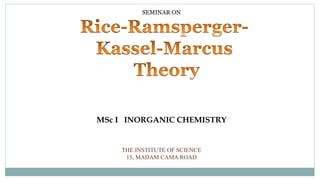
47rrkmtheory11 190428142321
- 1. SEMINAR ON MSc I INORGANIC CHEMISTRY THE INSTITUTE OF SCIENCE 15, MADAM CAMA ROAD
- 2. Contents Introduction Rice-Ramsperger-Kassel-Marcus (RRKM) Theory Energy scheme for RRKM theory Significance Applications Limitations Bibliography
- 3. Introduction Rice-Ramsperger-Kassel-Marcus (RRKM) Theory traces its origin from Lindemann-Christiansen approach to unimolecular reactions.
- 4. Assuming steady state approximation, The difficulty with the original Lindemann-Christiansen hypothesis was that the first order rates are maintained down to lower concentrations than the theory appeared to permit. This difficulty was overcome successfully by Hinshelwood.
- 5. Hinshelwood modified this treatment by considering collision theory:
- 6. Rice-Ramsperger-Kassel (RRK) considered the energy dependence.
- 7. Here M is any molecule including A, that can transfer energy to A when collision occurs. is the energized molecule and is the activated molecule. According to RRK, a molecule is treated as a system of loosely coupled oscillator, where a amount of energy is distributed among normal modes of vibrations. During vibrations, energy get transferred from one vibrational level to next vibrational level randomly. And if one of the vibrational mode get sufficient energy for activation then it will lead to product formation.
- 8. Rice-Ramsperger-Kassel-Marcus (RRKM) Theory During 1951-52, R.A. Marcus merged Transition State Theory (TST) with RRK theory and came up with Rice-Ramsperger-Kassel-Marcus (RRKM) Theory. Marcus followed the same mechanism as that in RRK theory but considered the energy to be distributed in active (vibrations) and in inactive (translations) states. In RRKM theory, the individual vibrational frequencies of the energized species and activated complexes are considered.
- 9. Account is taken on the way various normal modes of vibration and rotation contribute to reaction and allowance is made for zero point energies. The total energy contained in the energized molecule is classified as either active or inactive (also referred to as adiabatic). The inactive energy is the energy that remains in the same quantum state during the course of reaction and, therefore, cannot contribute to the breaking of bonds. The zero point energy is inactive, as is the energy of overall translation and rotation, since this energy is preserved as such when the activated molecule A# is formed.
- 10. Vibrational energy and the energy of internal rotations are active. In RRKM theory, the distribution function ∫ (𝜀*)d 𝜀* is calculated using quantum statistics and is given by Where 𝜌(𝜀*) is the density of states (DOS) having energy between 𝜀* and 𝜀*+ d 𝜀* . Density of states (DOS) is defined as the number of states per unit energy range.
- 11. The denominator of this equation is the partition function relating to the active energy contributions. According to the RRKM theory, the rate constant k2(𝜀*) is given by, Where 𝓁# is the statistical factor and ΣP(𝜀# active) is the number of vibration-rotation quantum states for the activated molecule corresponding to all energies upto and including 𝜀# active .
- 12. The factor Fr is introduced to correct for the fact that the rotations may not be the same in the activated molecule as in the energized molecule. A noteworthy feature of the RRKM theory is that it leads to the same expression for the limiting high pressure unimolecular (first-order) rate constant as is given by Transition State Theory (TST): Where q# and qi are the partition functions for the activated and initial states.
- 13. The energy scheme for the RRKM mechanism:
- 14. Significance RRKM theory can explain the abnormally high pre- exponential factors that are sometimes observed. In order to use RRKM theory for detailed calculations, we must decide on models for energized and activated molecules. Vibrational frequencies for the various normal modes must be estimated and decision made as to which energies are active and which are inactive. Numerical methods are used to calculate the rate constants k1 at various concentrations.
- 15. Applications The reactions which have been successfully investigated using RRKM theory include; • Isomerization of cyclopropane • Isomerization of cyclobutane • Dissociation of cyclobutane into two ethylene molecules The Isomerization of cyclopropane to propylene was the first unimolecular gaseous reaction investigated in the 1920s.
- 16. Limitations A major difficulty in applying RRKM theory is that the vibrational frequencies of the activated complexes usually cannot be estimated very reliably and there is evidence for non-RRKM behavior. In nonthermal activated unimolecular reactions, it has been found that the translational energy distribution of reaction fragments is non-statistical, contrary to the predictions of the RRKM theory. This implies that not all degrees of freedom participate in the fragmentation of the complex.
- 17. Bibliography Physical Chemistry by Puri, Sharma, Pathania
- 18. THANKYOU I EXPRESS MY SINCERE THANKS TO ALL MY PROFESSORS , SENIORS AND MY PARENTS. IMAGE